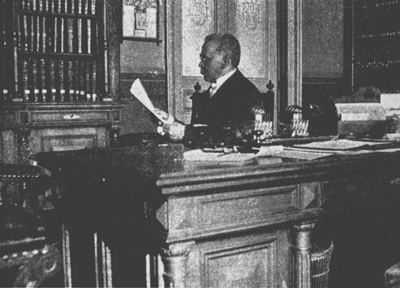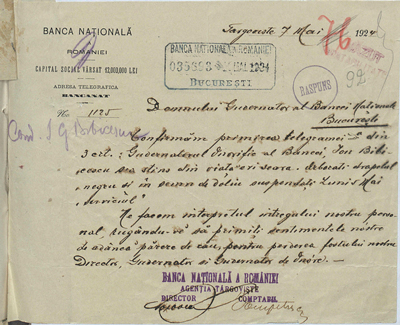Ioan G. Bibicescu saw the light of day 170 years ago, on 8/20 November 1848. He held the office of governor of the National Bank of Romania during World War One and at the time of the Great Union. He was at the helm of the National Bank first as deputy governor (1914 – 1916) and thereafter as its governor (1916 – 1921). On finishing his mandate as governor, Ioan G. Bibicescu was appointed honorary governor, for the meritorious services he had rendered to the central bank and the Romanian people.
Ioan G. Bibicescu was born in the village of Colibași, Mehedinți county, but shortly after that his parents moved to Turnu Severin, a town in full economic swing at that epoch. While attending the “Carol I” High school in Craiova, he found a passion for collecting coins and medals. After having graduated from high school, Bibicescu enrolled in the Law School within the University of Bucharest, but completed his studies in Paris. Upon his return to the country, he started to work for the Românul newspaper, under the supervision of C.A. Rosetti. It was there that he met Eugeniu Carada with whom he founded several newspapers such as: Dorobanțul, Renașterea, Unirea, Telegraful român.

Ioan G. Bibicescu in his managerial office
at the NBR (NBR’s Archive Library)
He started his activity at the National Bank of Romania in 1895, when he was appointed manager by the Government, an office he held until his nomination as deputy governor with governor’s prerogative powers on 21 February 1914, in the aftermath of Governor Anton Carp’s death. I.G. Bibicescu became governor on 11 December 1916, a few months after Romania had decided to fight in World War One alongside the Allied Powers. Some of the measures he took during his mandate at the National Bank of Romania related to: lending to the Romanian government to make it possible for the latter to bear the military drill and endowment costs to wage the war (the NBR incurred one third of these expenses); the intermediation of sales of cereals to Central Powers and the Great Britain in the aftermath of the State’s monopolisation of agricultural produce exports; the relocation of the National Bank’s headquarters to Iași and the decision to ship the treasure to Moscow; the issuing of banknotes with lei 1, 2 and 5 face values to compensate for the lack of small-value coins, owing to coin hoarding.

Picture of Governor
Ioan G. Bibicescu in
the Gallery of NBR governors
(NBR’s Archive Library)
After the end of World War One and following the Great Union of 1 December 1918, the National Bank of Romania faced new challenges such as: the monetary unification and the removal of notes and coins that had circulated in Bessarabia, Bukovina and Transylvania, namely the roubles, the Austro-Hungarian crowns, and the notes issued by German occupation authorities; the expansion of a network of branches across Greater Romania (the first branch was set up in Chișinău on 5 January 1919, a second one was then established in Cernăuți on 2 September and other six branches were opened in Transylvania on 6 November); and the restoration of the leu’s convertibility.

List of documents donated
by I. G. Bibicescu to the State Archives,
bearing the signature of
Professor Dimitrie Onciul,
Director General of the General Department of the State Archives
A journalist himself at the beginning of his career, Governor Bibicescu was a true humanitarian drawn to noble causes and eager to provide financial assistance to the modest but meritorious people. The list of charities the Bank engaged in during his mandate is long but diverse and a special mention deserves the lei 200,000 support extended to the University of Iași for the maintenance of hostels accommodating students coming from Bukovina, Bessarabia and Transylvania1. Ioan G. Bibicescu’s personality is all the more fascinating when looking at the discretion and modesty he displayed in the discharge of his tasks at the National Bank of Romania. At the central bank, he carried out an indefatigable activity in which he found plenty of satisfaction, in spite of the hard times during World War One and the first post-war years. According to his own words, “I took over the management of the Bank in unimaginably difficult times and I had to take the right measures”.

Telegram listing the measures taken
at the National Bank of Romania
upon the death of Governor Ioan G. Bibicescu
(NBR Archives)